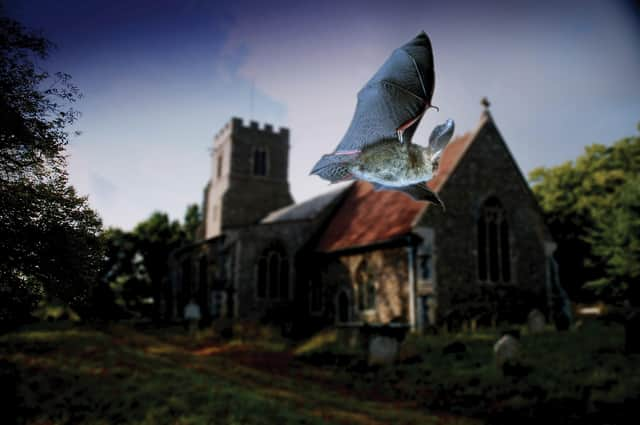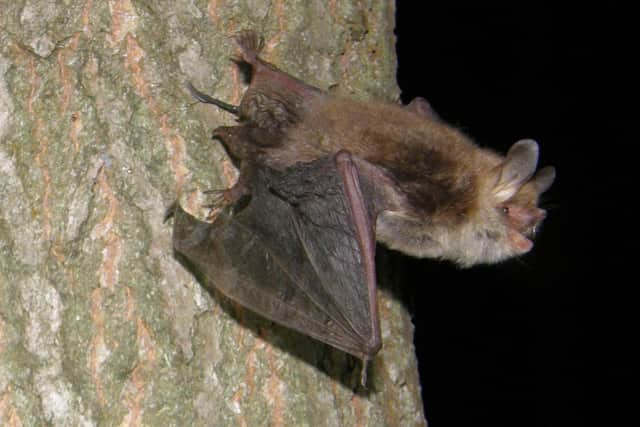Knepp Wildland Foundation column: How ancient churches are living with bat colonies


St George’s is home to a roosting colony of some 30 Natterer’s bats, charming little brown-grey furred critters with pink faces, long curved ears and stiff, short bristles along their tail membranes. During the summer females gather together companionably to birth single pups, breastfeed and teach their progeny the ways of echo-location and catching insects, before they fly the roost.
Pipistrelle bats, so tiny they can fit in a matchbox and weigh no more than a pound coin, and brown long-eared bats with their distinctive long ears textured like the inside of a mushroom, also visit St George’s, drawn to the church’s insect-rich grounds, ample roosting opportunities and, perhaps, even its quiet, meditative presence.
Advertisement
Hide AdAdvertisement
Hide AdDuring spring and summer, evenings at the church will be filled with screeches and songs, all pitched at a frequency too high for the human ear. The sounds bounce off stone tombs, wooden pews bearing the names of local villagers and farmers, and marble figures posing beneath the gauzy veils protecting them from the bats’ droppings.


Churches live with their bat colonies in varying states of harmony. Bats droppings and urine can cause considerable mess and corrode the ancient monuments. Contrary to popular belief, though, bats pose no threat to human health.
Bat populations have suffered catastrophic declines in the UK over the past decades because of habitat loss, pesticides destroying insects – their food source, exclusion from modern buildings, human disturbance and cat predation. As a protected species, bats and their roosts cannot be disturbed or moved except under a licence. Many churches welcome bats, recognising them both as indicators of a balanced ecosystem and part of Creation. Others find the burden of cleaning and the very presence of winged nocturnal creatures harder to manage.
Help is at hand, however. The Bats in Churches partnership is a five-year project between Natural England, the Church of England, Bat Conservation Trust, the Churches Conservation Trust and Historic England, majority-funded by the National Lottery Heritage Fund. In addition to practical help and education, it involves an ambitious citizen science project using volunteers to survey 1,000 churches across the country to understand how and why bats are using churches, to provide help with the physical burden of cleaning and protecting church interiors, and to raise awareness about these lovely, but often misunderstood, creatures.
You can sign up to survey your local church here.
Advertisement
Hide AdAdvertisement
Hide AdHere at St George’s, work is almost complete (carefully timed for the gap between hibernation and breeding) on installing a new ceiling to cover the timber beams where the bats roost. The bats will be able to live undetected within the church, and the congregation can continue undisturbed by their nocturnal cohabitants.
Just a few wingbeats away from St George’s, however, an important feeding ground for the bats is under threat from development. Plans to build 3,500 houses on Buck Barn in West Grinstead, a site containing rare ghyll woodland, ancient hedgerows, scrubland and a functioning floodplain, would deprive at least six bat species of their roosting, feeding and breeding habitat.
It’s a site that has also been identified by Sussex Wildlife Trust as an important part of its planned Nature Recovery Network – a project that aims to protect and improve wildlife connection between the Knepp rewilding project (home to 13 of the UK’s 17 species of bat) and St Leonard’s Forest, another local hotspot for bats.
If the development goes ahead, St George’s may become even more sacred for its winged congregation, one of the last prayers for these delicate, tiny mammals in our locality.
Comment Guidelines
National World encourages reader discussion on our stories. User feedback, insights and back-and-forth exchanges add a rich layer of context to reporting. Please review our Community Guidelines before commenting.